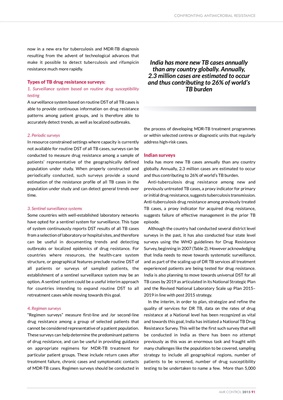
now in a new era for tuberculosis and MDR-TB diagnosis
resulting from the advent of technological advances that
make it possible to detect tuberculosis and rifampicin
resistance much more rapidly.
Types of TB drug resistance surveys:
1. Surveillance system based on routine drug susceptibility
testing
A surveillance system based on routine DST of all TB cases is
able to provide continuous information on drug resistance
patterns among patient groups, and is therefore able to
accurately detect trends, as well as localized outbreaks.
2. Periodic surveys
In resource constrained settings where capacity is currently
not available for routine DST of all TB cases, surveys can be
conducted to measure drug resistance among a sample of
patients' representative of the geographically defined
population under study. When properly constructed and
periodically conducted, such surveys provide a sound
estimation of the resistance profile of all TB cases in the
population under study and can detect general trends over
time.
3. Sentinel surveillance systems
Some countries with well-established laboratory networks
have opted for a sentinel system for surveillance. This type
of system continuously reports DST results of all TB cases
from a selection of laboratory or hospital sites, and therefore
can be useful in documenting trends and detecting
outbreaks or localized epidemics of drug resistance. For
countries where resources, the health-care system
structure, or geographical features preclude routine DST of
all patients or surveys of sampled patients, the
establishment of a sentinel surveillance system may be an
option. A sentinel system could be a useful interim approach
for countries intending to expand routine DST to all
retreatment cases while moving towards this goal.
4. Regimen surveys
"Regimen surveys" measure first-line and /or second-line
drug resistance among a group of selected patients that
cannot be considered representative of a patient population.
These surveys can help determine the predominant patterns
of drug resistance, and can be useful in providing guidance
on appropriate regimens for MDR-TB treatment for
particular patient groups. These include return cases after
treatment failure, chronic cases and symptomatic contacts
of MDR-TB cases. Regimen surveys should be conducted in
the process of developing MDR-TB treatment programmes
or within selected centres or diagnostic units that regularly
address high-risk cases.
Indian surveys
India has more new TB cases annually than any country
globally. Annually, 2.3 million cases are estimated to occur
and thus contributing to 26% of world's TB burden.
Anti-tuberculosis drug resistance among new and
previously untreated TB cases, a proxy indicator for primary
or initial drug resistance, suggests tuberculosis transmission.
Anti-tuberculosis drug resistance among previously treated
TB cases, a proxy indicator for acquired drug resistance,
suggests failure of effective management in the prior TB
episode.
Although the country had conducted several district level
surveys in the past, it has also conducted four state level
surveys using the WHO guidelines for Drug Resistance
Survey, beginning in 2007 (Table 2). However acknowledging
that India needs to move towards systematic surveillance,
and as part of the scaling up of DR TB services all treatment
experienced patients are being tested for drug resistance.
India is also planning to move towards universal DST for all
TB cases by 2019 as articulated in its National Strategic Plan
and the Revised National Laboratory Scale up Plan 2015-
2019 in line with post 2015 strategy.
In the interim, in order to plan, strategize and refine the
quality of services for DR TB, data on the rates of drug
resistance at a National level has been recognized as vital
and towards this goal, India has initiated a National TB Drug
Resistance Survey. This will be the first such survey that will
be conducted in India as there has been no attempt
previously as this was an enormous task and fraught with
many challenges like the population to be covered, sampling
strategy to include all geographical regions, number of
patients to be screened, number of drug susceptibility
testing to be undertaken to name a few. More than 5,000
CONFRONTING ANTIMICROBIAL RESISTANCE
AMR CONTROL 2015 91
India has more new TB cases annually
than any country globally. Annually,
2.3 million cases are estimated to occur
and thus contributing to 26% of world's
TB burden